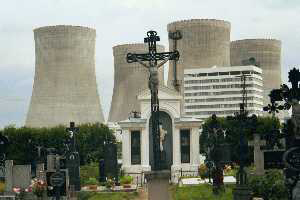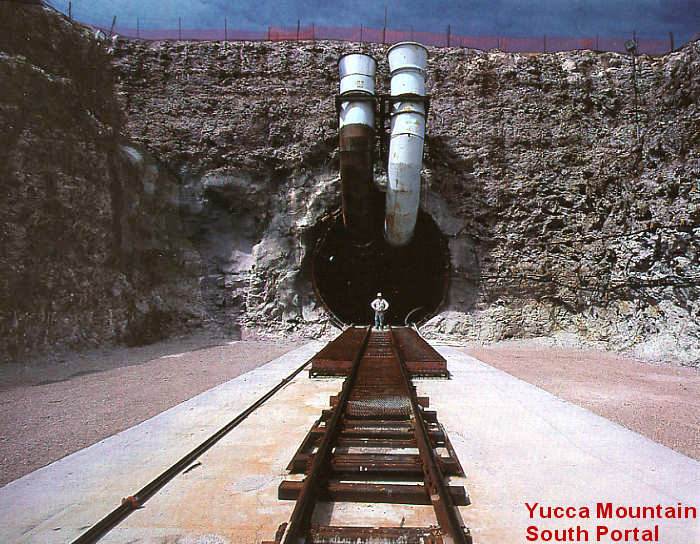Nuclear Power

Another one bites the dust: Czech utility CEZ cancels new reactors at Temelin; utility’s stock immediately rises more than three percent. CEZ had planned to build two new reactors at its long-controversial Temelin site, but wanted government subsidies to do so. Czech president President Milos Zeman refused to provide such subsidies and instead told CEZ to revoke its existing tender and try again to get an offer to build the reactors that wouldn’t require government support. CEZ knew that was impossible, and gave up on the idea entirely.
New York Times: Japan still wants to open reprocessing plant, stockpile more plutonium despite proliferation risks. It looks to us like Japan’s much-ballyhooed announcement last month about returning some plutonium to the U.S. wasn’t about proliferation concerns. Rather, we suspect Japan just wanted to unload some of its radioactive waste on the U.S., since Japan is even further behind than the U.S. on a disposal site.
People and elected officials on Cape Cod are not at all happy about NRC’s rejection yesterday of NIRS’ petition to expand emergency planning zones. Meanwhile, in nearby Vermont, Entergy wants to end emergency planning entirely once its Vermont Yankee reactor shuts down later this year, even though the reactor’s high-level radioactive waste will remain onsite for the foreseeable future. That idea is not likely to play well in Vermont, though it’s not clear what recourse the state may have. The NRC is actively working to make it easier for utilities with shutdown reactors to get exemptions from emergency planning requirements.
China’s nuclear program is beginning to look a lot like the failure of the U.S. nuclear “renaissance.” China is still rejecting inland nuclear reactors. As noted in GreenWorld earlier this week, nuclear’s share of Chinese generation capacity is at only 1.2% (it’s about 19% in the U.S.). While China’s nuclear construction program remains far more ambitious than anything in the West, it is dwarfed by China’s spending on renewables and nuclear is still unlikely to ever provide a significant share of the country’s electricity.
More delays are likely for the Summer nuclear project in South Carolina, according to a new report from state regulators. Note, the dollar amounts in this article are only for SCANA’s share of the project, not the full cost, which is far higher.
How to get away with almost anything. Essay in Bulletin of Atomic Scientists pointing out that in many developing countries–the focus here is on Pakistan–the nuclear industry is still a secret industry and that leads to lower safety standards and greater risk of disaster.
Publics indoctrinated in the virtues of nuclear weapons let their nations’ atomic energy establishments get away with almost anything. Public subsidies are dispensed for nuclear power, but hidden for secrecy reasons, and are thus excluded from the real costs of electricity. Nuclear establishments need not reveal their plans for disaster management, prove these plans’ adequacy, develop environmental impact mitigation schemes, or educate the population about radiation hazards. These establishments, operating almost unchallenged, feel little need to make the case for nuclear power over alternative energy technologies. Bureaucracies, shrouded in layer after layer of secrecy and relying on official secrecy acts, can continue to hide from the public gaze their appalling inefficiency and incompetence.
Here’s a hoot–and an exercise in self-delusion. Or maybe there’s just a desire to boost graduate school enrollment figures. In any case, a manager at Southern Company told a nuclear engineering graduate school gathering in Tennessee yesterday that 130,000 new workers will be needed to build the next 30 nuclear reactors in the U.S. Sounds like an echo of John McCain’s 2008 presidential campaign and the idea of 30 new reactors in the U.S. inevitably will follow the same fate as that campaign. But we do feel sorry for any students who believe such a fantasy and spend tens of thousands of dollars on a grad school curriculum that is not very likely to have the future its backers claim.
Clean Energy
A California county has become the first in the nation to be grid positive: it produces 152% of the energy it uses from solar.
Also in California, utility-scale solar power topped five percent of the state’s electricity needs in March, a new record. Renewables generally provided more than 22% of the state’s power. And those figures don’t count rooftop solar, which doesn’t show up in such estimates because for utilities it’s power they aren’t providing. But with 2.2 Gigawatts of rooftop solar already installed in California, solar would have bumped up a point or two.
Goldman Sachs plans to invest $40 Billion in renewable energy over the next ten years. That’s serious money from just one investment company. Stuart Bernstein, the head of Sachs’ clean energy group, says we are already in a period of rapid transition to clean energy but says Sach’s belief is that this will be a 20-year process.
Inside Washington

A Nevada Republican, Rep. Joe Heck, wants to name part of Frenchman Mountain in the state after former President Ronald Reagan–as if they weren’t already enough things named after him. But some members of the House Natural Resources Committee had a more appropriate idea: Rep. Peter DeFazio suggested naming the now-abandoned Yucca Mountain radioactive waste dump after Reagan. Said DeFazio, “If we were going to name something after the president, it ought to be something that actually had to do with the president’s service in office, and something the president supported that was extraordinarily significant to the state of Nevada.” The committee ended up approving Heck’s request, knowing that it is highly unlikely to get to the Senate floor controlled by Senate Majority Leader Harry Reid (D-Nev.).
Sometimes it’s not worth rooting for either side, but if anyone had doubts about how difficult this Congress is, read on. Energy Secretary Ernest Moniz continued to push his inane “all of the above” energy strategy on Capitol Hill yesterday, and said DOE needs more money to implement the strategy. House Republicans countered that the administration is too biased against fossil fuels and is waging a war on coal. The chair of the House Science, Space and Technology Committee, Rep. Lamar Smith (R-Tex.), complained that the Obama White House has continually proposed spending three to six times as much on investments in alternative energy sources, including wind and solar power, as on fossil fuels. “It certainly appears to me to be a not-balanced approach—not an ‘all of the above’ approach by this administration,” Smith said. Neither side appears to have noticed the changes taking place in the electricity sector, which is pushing away coal at least as fast as nuclear power, although Moniz did support the idea of new coal with carbon capture technology, which so far has proven remarkably expensive and ineffective.
Meanwhile, CNBC, which appears to be on a relentless pro-nuclear promotional campaign, touted an appearance by Moniz, in which he spoke favorably about small modular reactors and pushed the department’s existing loan guarantee programs, as a sign of a hopeful future for nuclear power. Never mind that the nuclear side of the loan guarantee program hasn’t been able to give away more than $10 billion it has remaining after the one loan–for the Vogtle reactors in Georgia–that it managed to eke out four years after announcing its approval. We have no idea if CNBC’s investment advice is any more accurate or in-depth than its reporting, but for the sake of its viewers we sure hope so.
Michael Mariotte
April 10, 2014
Permalink: https://www.nirs.org/2014/04/10/nuclear-newsreel-thursday-april-10-2014/
You can now support GreenWorld with your tax-deductible contribution on our new donation page here. We gratefully appreciate every donation of any size–your support is what makes our work possible.
Comments are welcome on all GreenWorld posts! Say your piece above. Start a discussion. Don’t be shy; this blog is for you.
If you like GreenWorld, you can help us reach more people. Just use the icons below to “like” our posts and to share them on the various social networking sites you use. And if you don’t like GreenWorld, please let us know that too. Send an e-mail with your comments/complaints/compliments to nirs@nirs.org. Thank you!
Note: If you’d like to receive GreenWorld via e-mail daily, send your name and e-mail address to nirs@nirs.org and we’ll send you an invitation. Note that the invitation will come from a GreenWorld@wordpress.com address and not a nirs.org address, so watch for it.




Dearest mm:
Thanks for reporting this, i get several news feeds on nuclear but i read it here first – which is perhaps appropriate. We met over my work on Temelin (and Chernobyl + 10) and it was there that you recruited me to the NIRS Board, one of my favorite jobs.
You can take credit for helping fostering the anti-nuclear movement in Europe. The NIRS micro grant program was in several cases the difference between groups being active and collapsing.
Paxus at Acorn
It was a once in a lifetime opportunity to provide substantive help to a fledgling and important movement at a cost NIRS could actually meet and sustain for at least a few years. That it was a success beyond expectations was the icing on the cake….hmmm, maybe I should say my wedding cake….